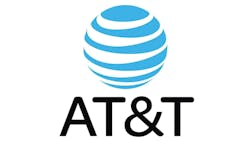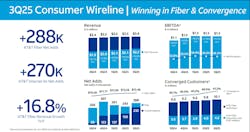AT&T’s CEO says its scalability enables agility in its fiber build
Key Highlights
- AT&T's fiber reach exceeds 31 million locations, with a goal to surpass 60 million by 2030, demonstrating aggressive market penetration.
- The company has doubled its fiber customer base in under five years, significantly increasing fiber-related revenues and customer engagement.
- 41% of AT&T Fiber customers also subscribe to wireless services, highlighting successful convergence strategies that reduce churn and increase lifetime value.
- AT&T is actively transitioning from copper to fiber and fixed wireless, supported by FCC policies encouraging network modernization and IP-based services.
- Fiber broadband growth contributed to an 8.2% increase in broadband revenue, with 288,000 fiber net adds in the third quarter, reflecting strong consumer demand.
AT&T is confident that its approach to fiber buildouts enables it to stand out against emerging fiber broadband competitors popping up in the markets it serves today.
Speaking to investors during its third-quarter earnings call, John Stankey, CEO of AT&T, said that the company’s fiber reach enables it to adjust its approach in the markets it looks to reach.
“We think we have the most scaled build engine in the industry,” he said. “With that scalability comes a degree of agility. It means we have the flexibility to work with our base and move supplies around. We try to be very deliberate about ensuring that everybody knows when the train rolls into town, that the train's in town.”
He added that “it's probably not a good place for anybody else to come and deploy their capital because this is a company that has a track record of going in and penetrating aggressively and being successful in markets.”
AT&T’s fiber momentum was reflected in its third-quarter results, where it saw gains in its fiber build.
At the end of the quarter, AT&T passed over 31 million total locations with fiber. The telco expects to reach more than 60 million customer locations by the end of 2030.
Perhaps an even more telling statistic is that AT&T reached over 10 million AT&T Fiber customers.
Stankey said, “We have more than doubled our fiber customer base in less than five years, and nearly tripling our quarterly fiber revenues over that same period.”
Convergence movement grows
One of the continual side effects of AT&T’s fiber build is its effect on its wireless customer base. As a key initial step to wireline and wireless convergence, AT&T is seeing more of its fiber customers also purchase wireless services.
In the market where it offers fiber, 41% of its AT&T Fiber customers are choosing AT&T’s wireless services.
“Once again, we saw strong growth in the portion of our Fiber customer base that also subscribes to Mobility services,” said Pascal Desroches, CFO of AT&T. “At the end of the third quarter, this convergence rate reached 41.5%, up 180 basis points from a year ago. This represents one of our largest convergence gains over the past three years.”
AT&T’s convergence movement is also being seen with its fixed wireless Internet Air subscriber base. During the third quarter, AT&T added 270,000 new Internet Air subscribers.
“Our success with convergence also extends to fixed wireless,” Stankey said. “More than half of our Internet Air subscribers also choose AT&T for their wireless service. Like fiber, these customers exhibit lower churn and drive higher lifetime values than customers with stand-alone services.”
The service provider is also keen to take advantage of the FCC’s move to enable service providers to advance the transition from copper and TDM-based technology to next-gen fiber and IP services.
In June, the FCC issued a Notice of Proposed Rulemaking to encourage what it says is the swift transition to IP-based networks and advanced communications services for consumers. The regulator proposes and seeks comments on revisions to the Commission’s network change disclosure rules and section 214(a) discontinuance processes to eliminate regulatory barriers and costs.
For its part, AT&T is working to shutter its legacy copper-based networks. Initially, AT&T can replace copper-based DSL broadband with fixed wireless in places where it is not building fiber, or replace it with fixed wireless if it is a market where it can overbuild a market with fiber right away.
Stankey said, “We're actively trying to hold those customers with more attractive conversion offers.”
“The supportive policy environment is also making it easier for us to transition away from outdated legacy infrastructure and invest in the AI-ready connectivity that Americans want and need,” Stankey said. “The bottom line is that we now have the right building blocks in place to realize our scaled fiber and fixed wireless ambitions, complete our wireless modernization, and successfully transition away from legacy infrastructure.”
Fiber drives consumer revenue gains
Fiber broadband continues to be the catalyst for growth in its consumer wireline unit.
Driven by broadband revenue growth of 8.2%, AT&T reported that third-quarter Consumer Wireline revenues rose 4.1% year over year to $3.6 billion due to fiber broadband growth, partially offset by declines in legacy voice and data services and other services.
Operating expenses were up 0.3% year over year due to higher depreciation expense driven by fiber investment and higher network-related costs. This was partially offset by lower content licensing fees and customer support costs.
“Our Consumer Wireline business unit also delivered another strong quarter,” said Desroches. “This was driven by topline growth and cost takeout, including lower expenses associated with our legacy copper network. As a result, Consumer Wireline EBITDA margins expanded by a robust 350 basis points year over year. Customer demand for our leading home internet offerings is growing, as we reported strong gains in both Fiber and Internet Air customers.”
Consumer Wireline broadband revenue grew during the quarter due to a 16.8% increase in fiber revenue. Consumer Wireline also delivered positive broadband net adds for the ninth consecutive quarter, driven by 288,000 AT&T Fiber net adds and 270,000 AT&T Internet Air net adds.
Desroches said the fiber additions reflect “seasonal tailwinds and the continued expansion of our fiber footprint” and that “in the fourth quarter of last year, we benefited from some pent-up demand following the 3rd quarter work stoppage in the Southeast.”
Looking forward to the rest of the year, Desroches added that in 2025, “we expect our Fiber net adds to exhibit typical seasonality in the fourth quarter when we usually see lower levels of new connections as we get deeper into the holiday season.”
Overall, AT&T reported total revenues of $30.7 billion.
Looking toward the full year of 2025, AT&T has reiterated its full-year financial guidance. The company said it is on target to report consolidated service revenue growth in the low-single-digit range.
Within its mobile and consumer fiber broadband segments, AT&T has forecasted 3% service revenue growth and mid-to-high teens growth, respectively.
For related articles, visit the Business Topic Center.
For more information on high-speed transmission systems and suppliers, visit the Lightwave Buyer’s Guide.
To stay abreast of fiber network deployments, subscribe to Lightwave’s Service Providers and Datacom/Data Center newsletters.
About the Author
Sean Buckley
Sean is responsible for establishing and executing the editorial strategy of Lightwave across its website, email newsletters, events, and other information products.




